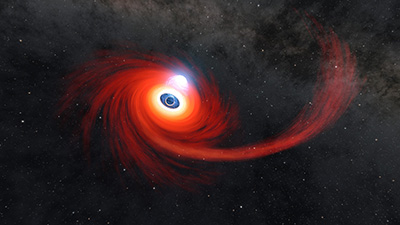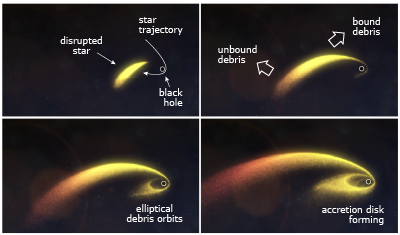
Artist's impression of a Tidal Disruption Event.
Image credit NASA/JPL-Caltech, 2022.
The LT was recently used to conduct a polarimetry monitoring campaign that targeted bright, long-lasting optical flares at the centres of five active galaxies. Debate exists on the physical mechanisms behind these transient events, and these new observations go some way to address the issues.
Most large galaxies harbour a supermassive black hole (SMBH) at their centres, and about 10% of these are "active". Active galactic nuclei (AGNs) are exceptionally luminous, thought to be caused by the black hole actively accreting matter.
The accretion process releases enormous amounts of enegy. Gas spiralling into the black hole forms an accretion disc, and through the release of gravitational forces and friction, the gas in the disc is heated to extremely high temperatures. The blackbody radiation thus emitted ranges from higher energy extreme ultraviolet/x-ray near the black hole to lower energy optical and infrared further out.

Simulation of star debris evolution during tidal disruption event (click for larger version). Annotated frames from video by NASA’s Goddard Space Flight Center/Chris Smith (USRA/GESTAR). Annotation by J. Marchant.
Most other galaxies with a central SMBH have no supply of infalling gas, so the SMBH is quiescent, and there is no AGN output. However, most galactic nuclei also host a dense cluster of stars. They are packed so tightly here that gravitational interactions between them are common, so some might end up on a collision course with the SMBH itself.
A star crossing the tidal radius of the SMBH would be partially or completely ripped apart in a tidal disruption event (TDE). A full disruption sees about half of the star debris leaving the SMBH vicinity entirely, but the rest remains gravitationally bound in various elliptical orbital streams.
As the streams interact with each other the friction and shock compression causes the debris to heat up and emit large amounts of radiation. It also loses orbital energy and the gas spirals into the SMBH, forming an accretion disc in the process, and emitting more radiation in a similar manner to that outlined above.
Normally quiescent galaxies might therefore undergo an occasional TDE-generated flare. The flare lasts from a few months to a few years, depending on the masses of the SMBH and the disrupted star, which in turn influence how much debris is produced and how fast it is accreted.
It was initially thought TDEs would peak in the extreme ultraviolet (EUV) and soft x-ray region. However, first observations saw the peak in the lower-energy UV/optical range instead.
This might be due to lower-orbital energy debris stream interactions, before the higher-orbital energy accretion disc has formed. Or it might be that the high energy EUV/X-rays from the disc centre are being blocked and reprocessed to lower-energy light by gas in the disk obscuring a direct view.
In an effort to constrain these models and obtain an idea of the geometry of the situation, Lorente-Mitjans et al observed a selection of recent candidate TDEs in polarised light. Polarisation can tell a lot about the engine powering the flares - colliding debris in elliptical orbits emit highly polarised light for instance, while reprocessed light from the disc is only mildly polarised.
The team used the LT's MOPTOP polarimeter to observe five TDE candidates. AT2024bgz, AT2024pvu and AT2024wsd were all thought to be "thermal" TDEs, exhibiting purely thermal blackbody radation. The other two (AT2020afhd & AT2019aalc) were thought to be "Bowen flouresence flares", exhibiting broad flourescence lines in addition to typical AGN spectra. These lines, very rare in AGN, might be from newly-launched jets, or from dense metal-rich gas accretion disc gas very close to the SMBH being ionised by transient EUV flares.
MOPTOP data showed the three thermal TDEs exhibited low polarisation levels (ΔP ~ 0-6%), implying the source was reprocessed light from the accretion disc centre. The observations were quite soon after the flare began, so the disc must have formed rapidly. This suggests the optical output from most thermal TDEs comes from reprocessed light from the already-formed accretion disk, rather than from the intersecting debris streams still in elliptical orbits earlier in the TDE timeline.
The two Bowen flares however showed a moderate amount of polarisation (ΔP ~ 0-8%) with the polarisation angle varying over time. In AT2020afhd, the angle rotated 83±8 degrees 150 days after peak brightness, implying a scattered light echo. With AT2019aalc the angle began swinging quasi-periodically by ~40 degrees 190 days after peak flare, implying a clumpy, asymmetric outflow and a tilted, precessing accretion disk. This might have been a partial TDE happening inside a pre-existing AGN gas-rich environment.
The authors conclude by stating the Vera Rubin Observatory's photometric survey, due to begin late 2025, will no doubt raise the annual TDE discovery rate from a few tens to a few thousand. Subsequent high-cadence followup polarimetry of this much larger dataset would let us know to a much greater statistical certainty how often TDE flares are caused by intersecting debris streams or reprocessed light from an established accretion disk.


